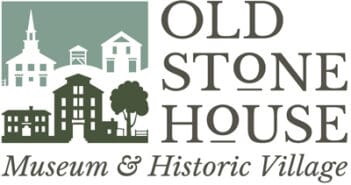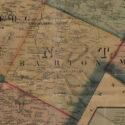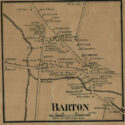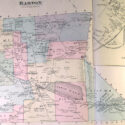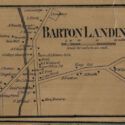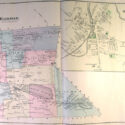Town Facts:
Barton
- Granted: 1781, to William Barton and his associates, including Ira Allen and John Paul Jones
- First settler: Asa Kimball, 1795
- Town government organized: 1798 (Reorganized in 1800 because legality of the government was questioned)
- Barton Village incorporated in 1874. The name was “Barton Mills” in early 19th century. Was an industrial center. The 1927 flood severely damaged the village, which has never fully recovered economically.
- Orleans is part of Barton town, but has its own village trustees (as does Barton village). Incorporated as village of Barton Landing, 1879.
- Annexed 3000 acres from the town of Sheffield in 1858.
- William Barton built the first sawmill in 1796. Asa Kimball built a gristmill in 1797 on the site later occupied by the chair factory.
- In March 1814, customs officers and local residents unsuccessfully battled a band of smugglers at Barton. The smugglers, however, retreated when their scouts reported a force waiting for them in Sheffield.
- Lee Emerson (1898-1976), governor of Vermont from 1951 to 1955, was a resident of Barton.
Orleans
- Orleans is part of Barton town, but has its own village trustees (as does Barton village). Incorporated as village of Barton Landing, 1879.
- First Building: Roger Enos’ sawmill at falls on Barton River, 1820.
- Known as Barton (or Barton’s) Landing from 1820 to 1908.
- Barton Landing grew slowly until railroad came in 1858. In 1875, the Connecticut and Passumpsic Railroad extended northward from Barton, resulting in growth for Barton Landing.
- Development increased with most growth of industry in 1870.
- 1890-1920 was period of most rapid growth.
- Roger Enos’s saw mill sawed lumber and manufactured spinning wheels and bedsteads. Through the years, it changed hands and names eleven times to finally become the Orleans Manufacturing Company which makes Ethan Allen Furniture.
Barton
From the Vermont Historical Gazetteer, edited by Abby Maria Hemenway. Orleans County –Barton Chapter: By Thomas May. Published by Claremont Manufacturing Co, 1877. Pgs 71-88.
Barton, bounded N. by Brownington, E. by Westmore and Sheffield, S. by Glover, W. by Irasburgh and Albany, containing 36 square miles, was granted Oct. 20, 1781, to William Barton and his associates, and five shares to be appropriated for public uses, as follows: one for colleges, one for the first settled minister one for grammar schools, one for common schools and one for the support of the ministry. The town is plotted in 160 acres, two lots to one right. The settlement of Barton was commenced by Asa Kimball in the spring of 1795. While clearing his land and raising his grain he lived in a cabin, constructed of poles and bark. The first grain that was raised was harrowed in with a cow and a steer. One of his steers failed for work when he got his land ready to sow and he yoked his cow with the other steer and harrowed in his grain. There was a family by the name of Eddy, who lived in Barton the winter of 1795, ’96, but left in the spring of ’96.
The first saw-mill was built by Wm. Barton in the summer of 1796, near where the railroad crosses the river at the Mansfield farm. The first grist-mill was built by Asa Kimball, in 1797, on the spot where the chair-factory now stands and a saw-mill was built by Asa Kimball in 1798, near where the grist-mill now stands. The first child born in town was Amelia May, Oct. 3, 1796, daughter of James and Elizabeth May. The first male child was George Abbott, born June 3, 1797; died July 20, 1797. The first adult person that died in town was I. Pilsbury’s hired man, Paul Blount, Sept. 1798. The town was first organized March 28, 1798.
The following is a true list of all the ratable property in the town for 1798, viz. 18polls, 26 acres of improved land, 3 houses, 18 oxen, 8 three year old steers, 20 cows, 9 two year olds, 8 horses, 1 horse two-year-old, 1 yearling colt, 2 watches, total $946.
LIST FOR 1803.-polls 39, improved land 302 acres, 13 houses, 22 oxen, 60 cows, three year olds 13. two year olds 21, horses 30, two year colts 1, sheep 120, -$2496.11.
LIST FOR 1810. Polls 81, acres improved land 300, ox an 77, cows and three year olds 168, two year olds 47, horses 60, two year old colts 6, houses 14, and 1 clock, -amount $37,387.00.
June 1803, this season the smallpox prevailed a considerable extent. We had 3 pesthouses. There was but two deaths from this disorder, one a child of David Blodget and a child that came from Glover.
Ellis Cobb built a fulling-mill for dressing cloth in 1803. Joseph Oven set up a still for manufacturing whiskey in 1804. Lemuel Sturtevant opened a store of goods in 1801, but continued the same only a short time. In 1800, Mrs. L. Sturtevant made a quilting and invited all the women in four towns, Barton, Brownington, Irasburgh and Glover. They all attended but one; two from each town except Barton.
The first barn was built by Daniel Pilsbury. The raisers came from Lyndon, finished the raising in the morning, and went back to Lyndon for breakfast.Oct. 6, 1806, at the raising of a building in this town, they had the body of the frame up, but the beams not entered, when a gust of wind struck the frame and blew it down, killing one young man instantly, while not so much as breaking the skin. He had been drawing up a beam, and stood in a brace when the gale came. He jumped, but the plate struck across his shoulders.
HARDSHIPS.The first settlers had to go to Lyndon and St. Johnsbury for all their milling and groceries 20 to 30 miles, no road but spotted trees, and bring them mostly on their backs. Joseph Eddy, who wintered in Barton in 1795 and ’96, used to be employed to transport their supplies. He brought for J. Robinson one time a five-pail kettle and half a bushel of meal, on his head. When most through he stopped at a spring and set the kettle down to drink and to rest awhile, and thought to leave the kettle by the spring and return for it. But, he stated, after starting little way he could not keep his balance without the kettle, and returned for it and brought it through.
In October, 1796, Daniel Owens, a young man about 25 years of age, started on horseback the afternoon to go to Lyndon. Night overtaking him, he tied his horse to a tree, took his saddle for a pillow, and camped out.
Two girls, Sally Haines about 16 years of age, and Almira, about 7 years, set out, neat sunset, to go from Mr. F. Matthews’ across the woods to Mr. B. Starkey’s, about three fourths of a mile distant. When about half way through the woods they lost their path and wandered until dark, when Sally sat down and held the little girl in her lap till morning. They had a large dog that kept with them, and they were found in the forenoon on the next day. The first coach came into this town in 1806. Hon. Daniel Owen and wife came to visit their children in a coach, and it was more of a curiosity to see than the locomotive of the present day.
In the Spring of 1809, the wolves were very troublesome among the sheep. There have been three wolves and quite a number of bears killed in this town. One year there were four bears killed in James May’s cornfield and the woods near by. And there used to be moose in the woods east toward the Connecticut River.
In the early settlement of this County, Daniel Young lived near the south corner of Barton, in the edge of Sheffield. He had one son, a dwarf, not so bright as some children. He went into the woods at one time to cut a whistle. His mother-upon missing him- started in search; but, her voice echoing beyond him, he only strayed deeper into the woods, and it was four or five days before he was found. All the men in Barton, Sheffield and adjoining towns, turned out to search the woods for him. When found, he had built him a house of small sticks, and was dancing round it. How he had subsisted is quite unknown; but he was certainly in fine spirits, and when asked, to frighten him, if he was not afraid of the bears, he said, “Georgie Miller has catched all the bears.”
Col. Bangs and Capt. Bigelow opened a store in 1805; Samuel Works in 1806; Abisha Goodel in 1809; R. Rogers went into trade with S. Works in 1809 and traded until 1812.
Elihu Lee commenced medical practice in 1802; Abner Phelps in 1809; F. W. Adams in 1813; Dr. Gregory in 1817; Silas C. McClary in 1819; Dr. Hoyt in 1823; Daniel Bates in 1836; F. W. Adams, who had some years before removed, returned here in 1821 and practiced until 1836; Anson Pierce practiced here in 1840; Hiram P. Hoyt came to the Landing to practice in 1841; George Fairbrother, Dr. Fisk, and Dr. Ranney have all practiced at the Landing. J. F. and R. B. Skinner have practiced in Barton since 1853. Rugles (homeopathy) has been in practice here 2 years.
The first lawyer that came to reside in town was Asa King, in 1811, who only staid about 6 months; Charles Davis, the second, came in 1816, and staid about 2 years; J. H. Kimball opened his office in 1824; George Mason practiced in 1830; Thomas Abbot in 1846; John P. Sartle in 1850; George Tucker in 1857; W. W. Grout in 1858; Jonah Grout, Jr., in 1865; John B. Robinson in 1865; Samuel S. Willard in 1870.
In the month of March, 1814, the U. S. custom officer; received information that a company of smugglers had crossed the line, intending to pass through this town. Accordingly calling to their assistance some of the inhabitants of this town and Irasburgh, they went out to meet them; which they did near the north line of the town, on the “Willoughby Hill.” There they had quite a hard battle. Several were severely wounded, on both sides. But the smugglers proved too strong a force for the custom officers and their party, and they drove through; having taken the precaution to send two ahead to see if there were likely to be any more obstructions in their way. After getting almost to Sheffield they met their scout returning with the information that there was, at Sheffield, a force ready to meet them; and they turned around and came back to the village, called at that time “Barton Mills.” Their load consisted of cloths, steel, wire, and various other things. They managed to secrete some of it. The custom officers seized a part, and took two prisoners. The prisoners were placed under keepers and taken to the inn of Jonathan Robinson; whence they managed to escape the next day. A man drove into the yard, and going into the house left his team without hitching. The prisoners rushed out, and, jumping into the sleigh, drove off, not stopping until they had crossed the boundary.
In August, 1814, a drove of cattle was seized by the officers of the customs, and put into a back pasture, on Jonathan Robinson’s farm. A party of men came from Canada to rescue them. In the darkness of the night, while hunting; for them, one John Weare was accidentally shot in the leg. He was taken on horseback and carried to the first house in Brownington, where his limb was amputated by Dr. F. W. Adams; using a beech with for his tourniquet, and a razor and sash-saw. The rest of the company made their escape to Canada.
In April, 1814, there were two pairs of saddle-bags, filled with steel, secreted by David Pilsbury. While the soldiers were stationed in town he informed the commanding officer when it was going to leave, and where to set a guard to take it. A corporal and one private were directed to go south into the woods, in Sheffield, and waylay them. When the men arrived, the soldiers stepped from behind a tree, and ordered them to dismount. The men begged the soldiers to let them go; but were told they must go back to camp. The soldiers drove the men, forward of them, back so far as Dexter’s tavern; when the men asked the soldiers if they would take a drink; and stepped into the tavern and brought out each a tumbler of sling, handing it to them. While they were drinking, the men snatched their guns and knocked them from off their horses, breaking one’s jaw and arm, threw the saddle-bags off and mounted their horses, and cleared for Barnet. The soldiers pressed every horse in the neighborhood that was fit to travel, and pursued them. When they came in sight of the house where the men were, the men leaped through a window in the back side of the house, and made their escape.
During the embargo there was a herd of cattle seized by the officers of the customs, and tied in E. Chamberlain’s barn. Two men were placed in the barn to guard them. The smugglers, who were on the alert, waited till they heard the guard snoring, when one of their party slipped in and turned out the cattle, and drove them off.
GLOVER POND [Runaway Pond]When Glover Pond was let out, June 6, 1810, the water rushed with such force upon us as to take the trees up by the roots on the meadow the whole length of the township; and in some places the water spread 100 rods wide, and in other places rose 25 feet, -heaping the timber in large piles, some 30 feet high. It swept every bridge from the stream, and one saw-mill. There was a log-house on the meadow 100 rods below where Roaring Brook empties into the river. The family, consisting of a man and his wife, had started to go over the river to the mills. They had to cross the river on a log, and had got upon the log over the river, when they heard the roar of the water, and turned and made their escape. The water came nearly to the eaves of the house. There was a pan of milk upon the table. After the water had passed off, they found the pan of milk safe on the table, though the water moved the house about two feet. A large elm stamp, below the house, prevented it from going off.
PONDS, RIVERS, OBES, ETC.Lake Crystal-first named by the French Belle Lac, is a beautiful sheet of water in the south part of the township, 21/2 miles in length and 1/2 mile in width. Fuller Pond, in the west part of the township covers a surface of about 100 acres, and there is another small pond upon the east, that lies partly in Barton and partly in Sheffield and Sutton. The principal rivers are Barton River and Willoughby. Barton River, the chief, runs through the town north and south. This town is not surpassed in New England for water power for mills and factories.- There are five dams within 100 rods below Crystal Lake. The brook that runs from the east corner of the town has good falls all the way to the lake. This stream is called May Brook, from its emptying into the lake on the May farm. There are two saw-mills on this brook. The greatest curiosity in this town is the stone flume in this brook. About half a mile from the lake there is a channel in the granite rock, 150 foot or more in length by 8 feet wide and 2.0 deep. There is a saw-mill built over it.
There have been some small bits of gold found in Willow River in this town; and some iron ore in some places.
BARTON VILLAGE is situated at the outlet of the Lake, and contains 2 dwellings, 132 families, 2 churches, 1 school-house, 1 hotel, 1 depot, 11 stores, 2 jewelers’ shops, 3 milliners’ shops, 3 blacksmiths’ shops, 4 shoemakers’ shops, 1 gristmill, 2 saw-mills, 1 clothier’s shop and carding machine, 1 chair factory, 3 sash, door andblind factories, 1 tin, sheet-iron and copperware shop, 2 brickmakers’ quarters, 2 shingle mills, one wheel-wright’s shop, 1 cabinetshop, 2 marble shops, 3 harness shops, a post office, “The Standard” printing office, Barton Academy, 3 lawyers’ offices, 3 doctors’ offices, and 2 dentists’ offices.
BARTON LANDING is in the north corner of the town, 5 miles from Barton Village. This village contains 46 dwelling; and 56 families, 1 saw-mill, 1 grist-mill, 1 starch-factory, 1 planing-mill, 1 carriage-shop, 2 shoemakers’ shops, 1 harness shop, 2 blacksmiths’ shops, a post-office, 5 stores, 1 milliner’s shop, 1 doctor’s office, 1 hotel, 1 school-house, 1 meeting-house, and a railroad depot.
JACKSVILLE, OR SOUTH BARTON VILLAGE, is 4 miles south of Barton Village, on a tongue of land that was taken from Sheffield. It contains 15 or 20 dwellings, 25 or 30 families, a post-office, a school-house, a store, a blacksmith’s shop, 3 saw-mills, and a railroad station.There are 9 school districts in town; whole number of scholars, 354; average attendance. 213; number of families, 347; the amount expended in schools, $15,
RELIGIOUS.
The first religions meeting was, in 1803 or 1804, appointed by Phineas Peck, a Methodist preacher, and held at Asa Kimball’s house. The first Congregational Church was organized, Aug. 27, 1807, by Rev. Elijah Lyman and Rev. Walter Chapin. The male members were Lemuel Sturtevant, Joseph Taber, John Brown, Samuel Thatcher, Cyrel Sturtevant, and Josiah Smith; the female members, Priscilla Sturtevant, Eunice Kimball, Alice Wadham, Rhoda Pilsbury, and several others. The first meeting-house was built in 1820, one mile north of the village, and occupied by the Congregationalists. The Methodists built a meeting-house in 1834, at the village. The Congregationalist built a meeting-house at the village in 1842. The meeting-house at the Landing was built in 1848. The Methodists occupy it most of the time. They formed a church there about that time. Our young men, mostly, when they arrive at maturity, seek a home in the West.
There are not over 30 or 35 men in town, over 21 years of age, who were born in town.
